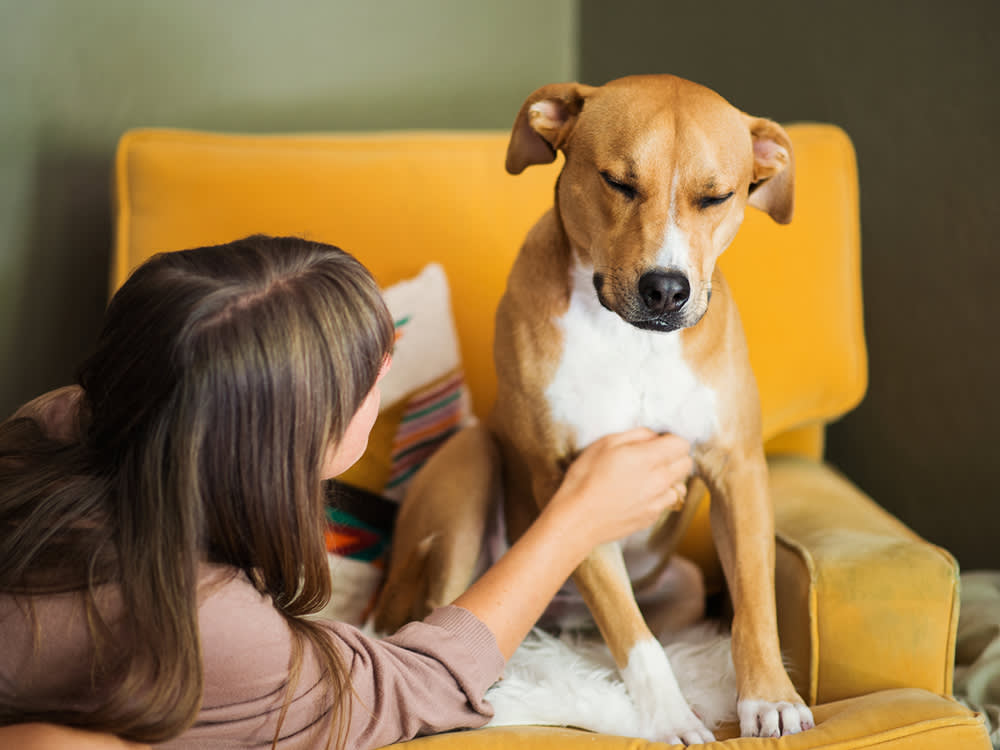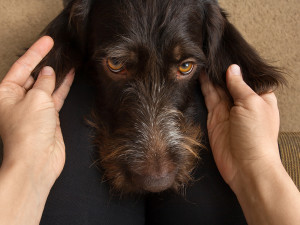DIY Physical Exam Part 4 — How to Examine Your Dog’s Stomach and Skeleton
Veterinarian Dr. Shea Cox on how to properly examine your dog’s stomach and musculoskeletal system.
In this series, we’re helping pet parents gain confidence in conducting basic health checks on their dogs. This installment will show you how to examine your dog’s stomach as well as their musculoskeletal system at home.
Examining The Stomach
Start with examining your dog’s stomach for this part of the physical exam: check for lumps and bumps, find out how a dog’s stomach should feel, and how to check for musculoskeletal issues. At the completion of this series of articles, you should feel totally prepared to perform a screening exam on your dog.
Save on the litter with color-changing tech that helps you better care for your cat.
How to Check Your Dog’s Stomach
The exam is pretty straightforward: touch and feel your dog’s stomach, starting just behind the ribs, and gently pressing your hands into the belly. Like all other parts of the body, you will be getting a feel for what is normal, and then continuing to monitor for any future changes.
If your pet has just eaten, you may be able to feel an enlargement in the left part of the belly just under the ribs (where the stomach “lives”), which can be normal just after eating. Continue by proceeding toward the rear of the body, passing your hands gently over the entire area. A dog’s stomach should feel soft and not swollen. If your dog’s stomach is hard, that could be a sign of bloat and requires immediate veterinary attention.
Normal
No lumps, bumps, or masses
No discomfort on palpation
No distention of the belly
Abnormal
Any lump, bump, or mass you feel.
Any examination with your fingers and hands (palpation) that causes groaning or difficulty breathing.
Any evidence or indication of pain is a serious finding and requires immediate attention; sudden and marked belly pain is what we refer to as “an acute abdomen” and can be caused by various conditions including pancreatitis (inflammation of the pancreas), sepsis (an infection in the belly that can be caused by a ruptured bowel or foreign body such as a foxtail), bleeding into the belly (such as from rat bait or a ruptured spleen), trauma, tumors or abscesses.
If the abdomen feels hard or tense and it appears distended: this is one of the major signs of bloat or GDV and immediate attention is needed!
How to Assess Your Dog’s Musculoskeletal System
There are many conditions that can all look like “a basic lameness” in dogs. Below are a few of the more common presentations and their potential causes.
Abnormal Signs
Lameness in any single leg: when a pet becomes lame, sources of the discomfort can be from the bone, soft tissue, joints, or tendon/ligaments.
A persistent, non-resolving lameness despite rest and medications: this requires veterinary attention because it could be a result of a type of bone cancer called Osteosarcomaopens in new tab; another typical presentation for bone cancer that I see is a pet that develops a very sudden and severely painful lameness following a “simple” act, such as jumping off the porch.
Loss of function or paralysis in hind legs: some causes include disease processes such as a herniated disk, cancer, infection, narrowing between the vertebrae of the spine, or degenerative myelopathy; losing the ability to walk is an emergency and immediate care is needed to help improve your pet’s chances of regaining mobility.
Recurring, shifting leg lameness, pain, and fever in a young dog: Panosteitis is a disease of the long bones of mostly young, growing large breed dogs; German Shepherd males are most frequently affected.
Limp tail: this is also known as “limber tail,” or “cold tail” and is a condition in which a working dog suddenly develops a flaccid tail; most dogs recover spontaneously within a few days to weeks, but evaluation by your veterinarian should be done because there are other diseases that can mimic a “limber tail” such as a tail fracture, spinal cord disease, impacted anal glands, and prostatic disease.
I hope this system’s approach to an “at-home physical exam” helps you to become familiar and stay in tune with what is normal for your pet. Performing these health checks in the comfort of your own home is the best way to recognize any early changes in your dog’s behavior. Consult your veterinarian if an abnormal condition exists or you are concerned about any exam finding. Early recognition can save the life of your pet.
By no means is this list exhaustive, and this information is intended as a general reference; it is not intended to replace professional advice or an examination by a veterinarian.





